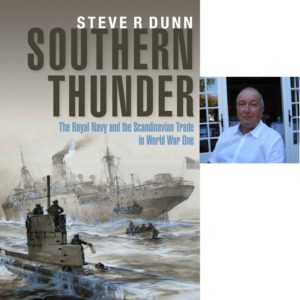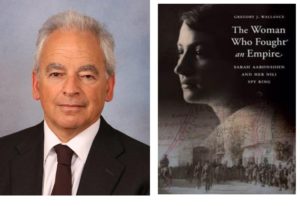
https://www.pen-and-sword.co.uk/Southern-Thunder-Hardback/p/15693
World War I naval operations evoke images of high seas and winter pea coats. That’s because much of the war at sea occurred around the coastlines of Northern Europe. It was most often a war of German u-boats silently hunting their prey and British ships patrolling for danger in cold and dangerous conditions. In his new book Southern Thunder, author Steven Dunn examines this brutal contest from the point of view of the Royal Navy.
One of the Royal Navy’s principal tasks was to stop trade between Germany and other nations who remained neutral or on the sidelines during the war. This included the Scandinavian nations and the United States. The Royal Navy was obliged to keep a sharp eye out to protect its own trading partners from u-boats and to stop and seize the ships trading with the enemy. It was no doubt a thankless but important job.
Though World War One ended 101 years ago, the importance and the devastation of that war live on. I posed some questions to Steven Dunn about Southern Thunder: The Royal Navy and the Scandinavian Trade in World War One and about the Royal navy’s activities.
How did you become interested in studying and writing on the subject of your book?
Southern Thunder is the last of a quartet of books dedicated to an examination of the British naval blockade of Germany in World War One. My interest in this little-known aspect of the war is part of my determination to ascribe to the Royal Navy more credit for British and Allied eventual success in the war than is generally allowed, a contribution which is often overlooked or played down.
Of course, the slaughter on the Western Front was an important part of the victory; but the Royal Navy’s maintenance of command of the sea denied Germany essential materiel and foodstuffs which eventually broke the morale of her people and hence that of her troops. Command of the sea also prevented Germany breaking Britain’s own supply chain through cruiser and U-boat warfare, although it was sometimes a close-run thing.
What aspect of this subject does your book focus on?
The book focuses on the naval plans and actions to prevent the three key Scandinavian countries, Norway, Sweden and Denmark, from supplying goods to the German war effort, either from their own resources or by acting as a channel for imports from abroad, primarily the USA.
All three countries had declared themselves neutral in August 1914 but attempted to make commercial gains from supplying to both sides of the conflict, and in some cases clearly leaning towards the Germany. It was the role of the Royal Navy and the British government to prevent such supply and ensure that Britain gained the resources she needed.
What are the major themes of this book?
The book examines the mechanics of blockade, the naval actions that supported it, the political and diplomatic campaign waged alongside the naval one, and the German response. It exposes governmental indecision and naval frustration, political negotiations, American profiteering and the impact of blockade on the Scandinavians themselves. The book’s narrative shows the day-today efforts of the Royal Navy in their attempts to cut off the Scando-German trade whilst protecting British commerce across the North Sea from predation by German submarines.
Additionally, Southern Thunder details the story of the introduction of convoy, throwing a different light on the traditional narrative, tells the compelling story of two set piece battles to defend Scandinavian convoys and pays due respect to those who lost their lives in the cold waters of the North Sea.
How did the Royal Navy handle Scandinavian ships trying to cross the blockade? Did these stops get violent? Were goods confiscated and crews imprisoned?
The Royal Navy stopped and searched all vessels it suspected of carrying contraband (i.e. goods for the enemy). Ships were usually instructed to heave-to by signal and then a small boat carrying a boarding and search party sent across. There was seldom violence but often passive resistance.
If contraband was found or believed to be present, a prize crew was put aboard and the ship sailed to a British port. Goods were then fully inspected and if appropriate condemned by a prize court. Vessels carrying contraband would be impounded and also condemned by the court.
Did you get a sense of how the German u-boats and British naval ships were able to track which Scandinavian ships were helping the enemy and which were supporting their side in trade? Was it mainly an issue of which trade routes were being used by the ship in question?
Trade routes were predictable and therefore ships easy to track in the beginning. Choke points on the approach to ports were the most dangerous. The Germans used espionage at Scandinavian ports to discover planned sailings.
The British stopped all ships that they encountered, if they could. The Germans torpedoed or otherwise sank on sight after the Unrestricted Submarine War declarations of February 1915 and January 1917.
The geographic area at issue seems to have been quite cramped operationally speaking. Did you come across any unusual events that occurred with so much ship activity going on in that area during the war?
In such a cramped environment and with the prevailing bad weather conditions for most of the year, ships were often in danger of collision. One must remember that there was no radar or other form of becoming aware of another ship, apart from the ‘mark 1 eyeball’.
The tragic collision between HMS Marmion and HMS Tirade in October 1917 was such an event. In a filthy night of high seas and strong winds the two ships literally drove into each other and seventy-six men from Marmion died.
What goods were the Scandinavian countries shipping to the countries fighting in WWI?
Was a lot of this shipping conducted with the open support of the Scandinavian governments or were the shippers generally behaving as “mercenaries” on their own?
Britain and German both required iron ore, copper ores, pit props and other timber and fish from Norway and Sweden. Additionally, Sweden exported some horses to Germany. Denmark exported diary products, meat and horses.
All three countries re-exported to Germany goods supplied by America. Export was undertaken with the consent of their governments who were placed under diplomatic pressure to prevent it by Britain and Germany, pressure which was generally ignored. They seldom stopped for very long until the British set up the Ministry of Blockade in 1916 and began to apply severe sanctions. The trade only really ceased after America joined the war and banned its own citizens from supply to the Scandinavia, except by quota.
What resource materials did you use for your research?
The book required a considerable amount of research. It is my writing style to try to source as many first-hand accounts of the subject as possible. Contemporary books and newspapers were a help here, as were the many personal diaries and notes held at institutions such as The National Archives at Kew, the Imperial War Museum in London, the Churchill Archive, Churchill College, Cambridge (my favourite archive!), the National Maritime Museum, Greenwich, the University of Edinburgh, the Liddle Collection, Leeds University Library, and the Shetland Museum and Archive, Lerwick.
What are some of your favorite naval vessels or civilian ships from this period and why?
I think one has to admire the crews of the old River-class destroyers, already largely obsolescent at the start of the war, lightly armed, smaller than the U-boats they sought to find and sink and never intended for blue water operation in the North Sea. They were pressed into service as U-boat hunters and convoy escorts and the quotidian bravery of captains and crews in vessels such as HMS Itchen and HMS Ouse deserves our respect.
What part of the research process was most enjoyable for you?
Sometimes I wonder if in a previous life I was a detective! I love tracking points through various archive materials to get to a new or fresh aspect. And reading original documents, written at the time, now yellowing and often hard to read, allows the author to access the real men behind the actions they fought.
What did you discover in your research that most surprised you?
I was surprised at the number of sailing ships still in use in the North Sea during 1914-18 for transport of goods and people. They were easy prey for U-boats.
Was there anything you discovered that moved you?
I never fail to be surprised and awed at the quotidian and understated stoicism and bravery of the ordinary sailors, naval and merchant, of that time.
What do you hope the book will do for readers?
With the passing of the centenary I believe there is a real danger that the First World War will begin to diminish in the public consciousness. This would be a betrayal of those who fought and died in a terrible conflict. We have to work even harder to make sure they are not forgotten and I hope that my books will cause people to reflect on the war’s legacy, good and bad, and that peace always has a price.
Moreover, many people have told me they were surprised to discover just how the Scandinavians involved themselves in the war behind a cloak of neutrality.
Did you have any difficulties in finishing the book and publishing it and if so, how did you overcome those?
The book was commissioned by the specialist naval publisher, Seaforth, who have published the last four of my books.
It is both difficult to start and to finish a book. I have a writing strategy by which I write a quick ‘version one’, which allows me to understand how the book starts and finishes. I then write a fuller version which expands key points and lets me see where I need to do further research. And finally, I write a third and final draft.
What are your future writing projects?
I am currently writing for two commissions, a book which looks at the Royal Navy’s actions immediately after the First World War, to be published by Seaforth in January 2020, and another which examines the broader history of the Royal Navy to be published in January 2021.
Do you have any online accounts where people can find more of your work?
Interested readers can view my website at;
I am on Twitter at @SteveRDunn
My books are available from all good bookshops, and on-line from Amazon and Pen and Sword
Steve R Dunn is an author with a special interest in the Royal Navy of the early 20th century and World War One. He has seven published books to his credit, with another two commissioned for 2020 and 2021, and is a regular speaker on the topics raised in his work. When not writing Steve plays tennis and cooks. He lives in Worcestershire, England, and South West France. He is a member of The Society for Nautical Research and the Britannia Naval Research Association.
More interviews: https://warscholar.org/posted-military-history-book-interviews/



